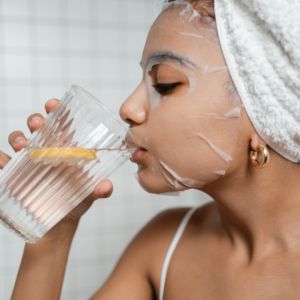Whereabouts in our cycles are we most likely to experience breakouts?
Research indicates that between one and two thirds of female acne sufferers will have a flare around the time of their period. This is typically in the late luteal phase of the menstrual cycle, which falls between days 22 and 28 for those with regular 28 day cycles. Interestingly, one study found that post-adolescent women may be more likely to experience this peri-menstrual flare than teens.
A lot of women say breakouts are worse during their period. Why is this? Can you explain the hormonal link?
We know that spots are caused by a mixture of sebum and dead skin cells getting trapped in our pores, along with inflammation from a bacterium called p.acnes. What we don’t precisely understand is how hormones affect this process. Progesterone levels rise to a peak mid cycle, before dropping off again, and may increase congestion through increased sebum production. Androgen (testosterone) levels are pretty stable throughout the cycle, but are relatively high compared to falling oestrogen and progesterone levels just before our period starts. This may be why oil production and pore blocking by dead skin cells (known as follicular hyperkeratosis) peak at this stage and is the most likely explanation for breakouts at this time.
What can we do to minimise angry breakouts around our period? Should we switch up our skincare routines depending on the time of the month?
There are definitely some measures that can be put in place to help reduce the impact of these flare-ups, but chopping and changing your skincare routine every few days to try and keep up with changes in hormone levels is not one of them. Consistency is key. It is important to develop a regimen appropriate for spot-prone skin and to stick to it as much as possible, remembering to cleanse twice daily and only use non-comedogenic beauty products and makeup. Adding topical benzoyl peroxide, retinol or salicylic acid to your routine can help unblock pores by removing dead skin cells, decrease greasiness and reduce redness and inflammation.
What if we’ve tried everything we can at home and need more help?
The combined contraceptive pill, which contains both oesterogen and progesterone, can work very well for women who suffer with worsening breakouts around the time of their period. Pills with anti-androgen activity can be especially helpful. Yasmin is an example. Beyond this, more specialised oral treatment options such as antibiotics, Roaccutane or spironolactone may be necessary and should be discussed with a Consultant Dermatologist who has a specialist interest in acne care.
If you are struggling with breakouts and would like treatment that really works, give us a call on 02037333225 and come see me in the clinic to discuss how I can help you.
© 2018 Dr Justine Kluk. Any redistribution or reproduction of part or all of the contents of this post in any form is prohibited. You may not, except with our express written permission, copy, distribute or commercially exploit the content. Nor may you transmit it or store it in any other website or other form of electronic retrieval system.






